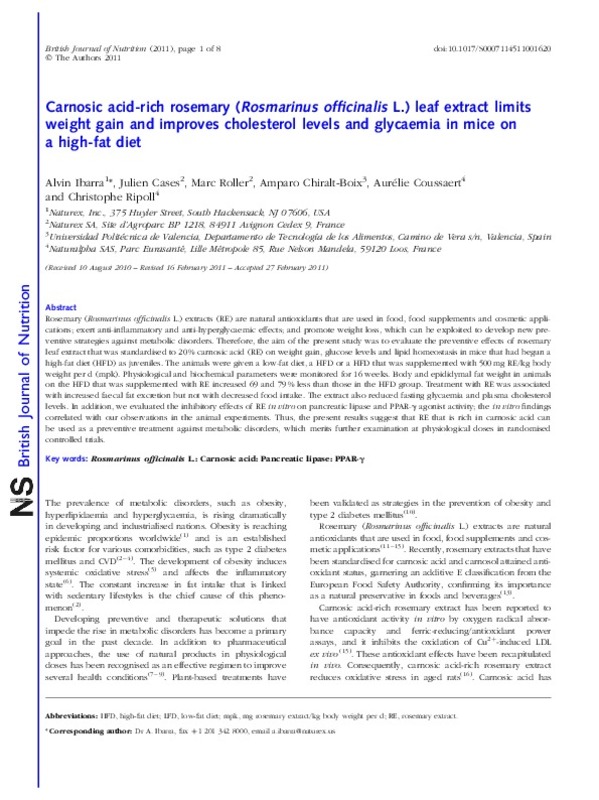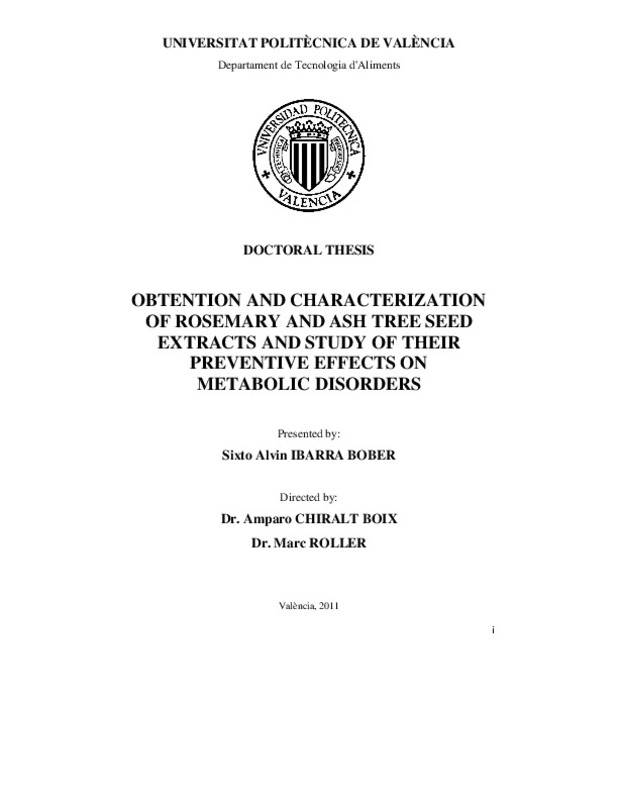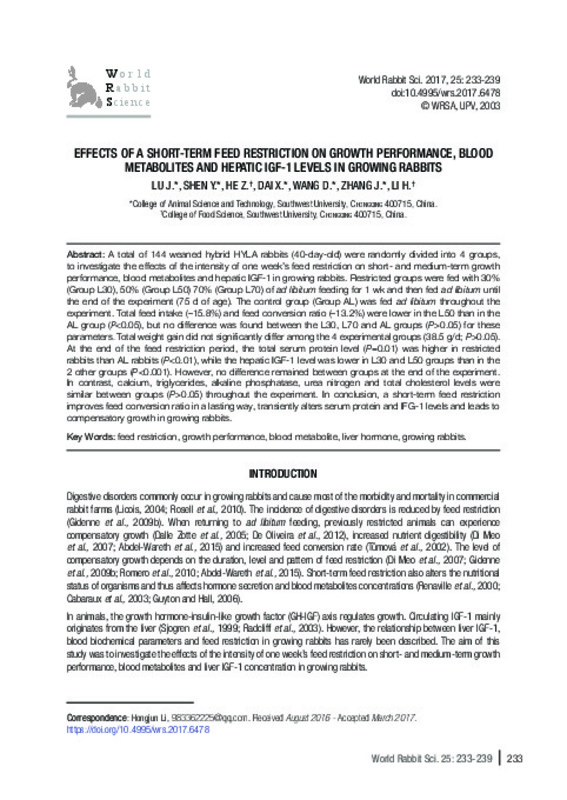JavaScript is disabled for your browser. Some features of this site may not work without it.
Buscar en RiuNet
Listar
Mi cuenta
Estadísticas
Ayuda RiuNet
Admin. UPV
Carnosic acid-rich rosemary (Rosmarinus officinalis L.) leaf extract limits weight gain and improves cholesterol levels and glycaemia in mice on a high-fat diet
Mostrar el registro sencillo del ítem
Ficheros en el ítem
| dc.contributor.author | Ibarra, Alvin
|
es_ES |
| dc.contributor.author | Cases, Julien
|
es_ES |
| dc.contributor.author | Roller, Marc
|
es_ES |
| dc.contributor.author | Chiralt, A.
|
es_ES |
| dc.contributor.author | Coussaert, Aurélie Coussaert
|
es_ES |
| dc.contributor.author | Ripoll, Christophe
|
|
| dc.date.accessioned | 2013-04-16T11:14:56Z | |
| dc.date.available | 2013-04-16T11:14:56Z | |
| dc.date.issued | 2011 | |
| dc.identifier.issn | 0007-1145 | |
| dc.identifier.uri | http://hdl.handle.net/10251/27906 | |
| dc.description.abstract | Rosemary (Rosmarinus officinalis L.) extracts (RE) are natural antioxidants that are used in food, food supplements and cosmetic applications; exert anti-inflammatory and anti-hyperglycaemic effects; and promote weight loss, which can be exploited to develop new preventive strategies against metabolic disorders. Therefore, the aim of the present study was to evaluate the preventive effects of rosemary leaf extract that was standardised to 20 % carnosic acid (RE) on weight gain, glucose levels and lipid homeostasis in mice that had begun a high-fat diet (HFD) as juveniles. The animals were given a low-fat diet, a HFD or a HFD that was supplemented with 500 mg RE/kg body weight per d (mpk). Physiological and biochemical parameters were monitored for 16 weeks. Body and epididymal fat weight in animals on the HFD that was supplemented with RE increased 69 and 79 % less than those in the HFD group. Treatment with RE was associated with increased faecal fat excretion but not with decreased food intake. The extract also reduced fasting glycaemia and plasma cholesterol levels. In addition, we evaluated the inhibitory effects of RE in vitro on pancreatic lipase and PPAR-¿ agonist activity; the in vitro findings correlated with our observations in the animal experiments. Thus, the present results suggest that RE that is rich in carnosic acid can be used as a preventive treatment against metabolic disorders, which merits further examination at physiological doses in randomised controlled trials. © Copyright © The Authors 2011. | es_ES |
| dc.description.sponsorship | Naturex is involved in the research/development and marketing/sales of rosemary extracts as ingredients for the food, cosmetic and nutraceutical industries. Therefore, Naturex has a commercial interest in this publication. Naturalpha was paid by Naturex to perform and report the scientific work that formed the basis of this publication. Naturalpha and Naturex declare that the data in this report represent a true and faithful representation of the work that has been performed. The financial assistance from Naturex is gratefully acknowledged. A. I. and C. R. designed the protocol. J. C. and M. R. developed the sample of RE. The study was conducted under the supervision of A. C. A. C.-B. analysed the data and reviewed the manuscript. | en_EN |
| dc.format.extent | 8 | es_ES |
| dc.language | Español | es_ES |
| dc.publisher | Cambridge University Press | es_ES |
| dc.relation.ispartof | British Journal of Nutrition | es_ES |
| dc.rights | Reserva de todos los derechos | es_ES |
| dc.subject | Carnosic acid | es_ES |
| dc.subject | Pancreatic lipase | es_ES |
| dc.subject | PPAR-¿ | es_ES |
| dc.subject | Rosmarinus officinalis L. | es_ES |
| dc.subject | Cholesterol | es_ES |
| dc.subject | Fatty acid | es_ES |
| dc.subject | Glucose | es_ES |
| dc.subject | Insulin | es_ES |
| dc.subject | Peroxisome proliferator activated receptor gamma | es_ES |
| dc.subject | Rosiglitazone | es_ES |
| dc.subject | Rosmarinus officinalis extract | es_ES |
| dc.subject | Triacylglycerol | es_ES |
| dc.subject | Triacylglycerol lipase | es_ES |
| dc.subject | Animal cell | es_ES |
| dc.subject | Animal experiment | es_ES |
| dc.subject | Article | es_ES |
| dc.subject | Body weight | es_ES |
| dc.subject | Caloric intake | es_ES |
| dc.subject | Cholesterol blood level | es_ES |
| dc.subject | Chronic drug administration | es_ES |
| dc.subject | Controlled study | es_ES |
| dc.subject | Epididymis fat | es_ES |
| dc.subject | Epididymis fat weight | es_ES |
| dc.subject | Experimental model | es_ES |
| dc.subject | Fatty acid blood level | es_ES |
| dc.subject | Fecal fat excretion | es_ES |
| dc.subject | Feces analysis | es_ES |
| dc.subject | Food intake | es_ES |
| dc.subject | Glucose blood level | es_ES |
| dc.subject | In vitro study | es_ES |
| dc.subject | Insulin blood level | es_ES |
| dc.subject | Juvenile animal | es_ES |
| dc.subject | Lipid diet | es_ES |
| dc.subject | Liver weight | es_ES |
| dc.subject | Low fat diet | es_ES |
| dc.subject | Male | es_ES |
| dc.subject | Mouse | es_ES |
| dc.subject | Nonhuman | es_ES |
| dc.subject | Plant leaf | es_ES |
| dc.subject | Triacylglycerol blood level | es_ES |
| dc.subject | Weight gain | es_ES |
| dc.subject | Animals | es_ES |
| dc.subject | Antioxidants | es_ES |
| dc.subject | Blood Glucose | es_ES |
| dc.subject | Diet, High-Fat | es_ES |
| dc.subject | Diterpenes, Abietane | es_ES |
| dc.subject | Eating | es_ES |
| dc.subject | Metabolic Diseases | es_ES |
| dc.subject | Mice | es_ES |
| dc.subject | Mice, Inbred C3H | es_ES |
| dc.subject | Organ Size | es_ES |
| dc.subject | Phytotherapy | es_ES |
| dc.subject | Plant Extracts | es_ES |
| dc.subject | Plant Leaves | es_ES |
| dc.subject | Rosmarinus | es_ES |
| dc.subject | Animalia | es_ES |
| dc.subject | Mus | es_ES |
| dc.subject | Rosmarinus officinalis | es_ES |
| dc.subject.classification | TECNOLOGIA DE ALIMENTOS | es_ES |
| dc.title | Carnosic acid-rich rosemary (Rosmarinus officinalis L.) leaf extract limits weight gain and improves cholesterol levels and glycaemia in mice on a high-fat diet | es_ES |
| dc.type | Artículo | es_ES |
| dc.identifier.doi | 10.1017/S0007114511001620 | |
| dc.rights.accessRights | Abierto | es_ES |
| dc.contributor.affiliation | Universitat Politècnica de València. Departamento de Tecnología de Alimentos - Departament de Tecnologia d'Aliments | es_ES |
| dc.description.bibliographicCitation | Ibarra, A.; Cases, J.; Roller, M.; Chiralt Boix, MA.; Coussaert, AC.; Ripoll, C. (2011). Carnosic acid-rich rosemary (Rosmarinus officinalis L.) leaf extract limits weight gain and improves cholesterol levels and glycaemia in mice on a high-fat diet. British Journal of Nutrition. 106(8):1-8. doi:10.1017/S0007114511001620 | es_ES |
| dc.description.accrualMethod | S | es_ES |
| dc.relation.publisherversion | http://journals.cambridge.org/action/displayAbstract?fromPage=online&aid=8411563 | es_ES |
| dc.description.upvformatpinicio | 1 | es_ES |
| dc.description.upvformatpfin | 8 | es_ES |
| dc.type.version | info:eu-repo/semantics/publishedVersion | es_ES |
| dc.description.volume | 106 | es_ES |
| dc.description.issue | 8 | es_ES |
| dc.relation.senia | 41461 | |
| dc.contributor.funder | Naturex | |
| dc.description.references | Furukawa, S., Fujita, T., Shimabukuro, M., Iwaki, M., Yamada, Y., Nakajima, Y., … Shimomura, I. (2004). Increased oxidative stress in obesity and its impact on metabolic syndrome. Journal of Clinical Investigation, 114(12), 1752-1761. doi:10.1172/jci21625 | es_ES |
| dc.description.references | YOUNG, S. C., & HUI, D. Y. (1999). Pancreatic lipase/colipase-mediated triacylglycerol hydrolysis is required for cholesterol transport from lipid emulsions to intestinal cells. Biochemical Journal, 339(3), 615-620. doi:10.1042/bj3390615 | es_ES |
| dc.description.references | Takahashi, T., Tabuchi, T., Tamaki, Y., Kosaka, K., Takikawa, Y., & Satoh, T. (2009). Carnosic acid and carnosol inhibit adipocyte differentiation in mouse 3T3-L1 cells through induction of phase2 enzymes and activation of glutathione metabolism. Biochemical and Biophysical Research Communications, 382(3), 549-554. doi:10.1016/j.bbrc.2009.03.059 | es_ES |
| dc.description.references | Surwit, R. S., Feinglos, M. N., Rodin, J., Sutherland, A., Petro, A. E., Opara, E. C., … Rebuffe-Scrive, M. (1995). Differential effects of fat and sucrose on the development of obesity and diabetes in C57BL/6J and mice. Metabolism, 44(5), 645-651. doi:10.1016/0026-0495(95)90123-x | es_ES |
| dc.description.references | Rau, O., Wurglics, M., Paulke, A., Zitzkowski, J., Meindl, N., Bock, A., … Schubert-Zsilavecz, M. (2006). Carnosic Acid and Carnosol, Phenolic Diterpene Compounds of the Labiate Herbs Rosemary and Sage, are Activators of the Human Peroxisome Proliferator-Activated Receptor Gamma. Planta Medica, 72(10), 881-887. doi:10.1055/s-2006-946680 | es_ES |
| dc.description.references | Muls, E., Kolanowski, J., Scheen, A., & Van Gaal, L. (2001). The effects of orlistat on weight and on serum lipids in obese patients with hypercholesterolemia: a randomized, double-blind, placebo-controlled, multicentre study. International Journal of Obesity, 25(11), 1713-1721. doi:10.1038/sj.ijo.0801814 | es_ES |
| dc.description.references | Raskin, I., Ribnicky, D. M., Komarnytsky, S., Ilic, N., Poulev, A., Borisjuk, N., … Fridlender, B. (2002). Plants and human health in the twenty-first century. Trends in Biotechnology, 20(12), 522-531. doi:10.1016/s0167-7799(02)02080-2 | es_ES |
| dc.description.references | Ninomiya, K., Matsuda, H., Shimoda, H., Nishida, N., Kasajima, N., Yoshino, T., … Yoshikawa, M. (2004). Carnosic acid, a new class of lipid absorption inhibitor from sage. Bioorganic & Medicinal Chemistry Letters, 14(8), 1943-1946. doi:10.1016/j.bmcl.2004.01.091 | es_ES |
| dc.description.references | Black, B. L., Croom, J., Eisen, E. J., Petro, A. E., Edwards, C. L., & Surwit, R. S. (1998). Differential effects of fat and sucrose on body composition in AJ and C57BL/6 mice. Metabolism, 47(11), 1354-1359. doi:10.1016/s0026-0495(98)90304-3 | es_ES |
| dc.description.references | Mengoni, E. S., Vichera, G., Rigano, L. A., Rodriguez-Puebla, M. L., Galliano, S. R., Cafferata, E. E., … Vojnov, A. A. (2011). Suppression of COX-2, IL-1β and TNF-α expression and leukocyte infiltration in inflamed skin by bioactive compounds from Rosmarinus officinalis L. Fitoterapia, 82(3), 414-421. doi:10.1016/j.fitote.2010.11.023 | es_ES |
| dc.description.references | Ibarra, A., Cases, J., Bily, A., He, K., Bai, N., Roller, M., … Ripoll, C. (2010). Importance of Extract Standardization and In Vitro/Ex Vivo Assay Selection for the Evaluation of Antioxidant Activity of Botanicals: A Case Study on Three Rosmarinus officinalis L. Extracts. Journal of Medicinal Food, 13(5), 1167-1175. doi:10.1089/jmf.2009.0259 | es_ES |
| dc.description.references | Ye, J. (2008). Editorial [Hot Topic:Botanical Treatments for Diabetes and Obesity (Guest Editor: Jianping Ye)]. Endocrine‚ Metabolic & Immune Disorders-Drug Targets, 8(2), 77-77. doi:10.2174/187153008784534312 | es_ES |
| dc.description.references | Gregor, M. F., & Hotamisligil, G. S. (2011). Inflammatory Mechanisms in Obesity. Annual Review of Immunology, 29(1), 415-445. doi:10.1146/annurev-immunol-031210-101322 | es_ES |
| dc.description.references | Sheng, L., Qian, Z., Zheng, S., & Xi, L. (2006). Mechanism of hypolipidemic effect of crocin in rats: Crocin inhibits pancreatic lipase. European Journal of Pharmacology, 543(1-3), 116-122. doi:10.1016/j.ejphar.2006.05.038 | es_ES |
| dc.description.references | Balunas, M. J., & Kinghorn, A. D. (2005). Drug discovery from medicinal plants. Life Sciences, 78(5), 431-441. doi:10.1016/j.lfs.2005.09.012 | es_ES |
| dc.description.references | Jouad, H., Haloui, M., Rhiouani, H., El Hilaly, J., & Eddouks, M. (2001). Ethnobotanical survey of medicinal plants used for the treatment of diabetes, cardiac and renal diseases in the North centre region of Morocco (Fez–Boulemane). Journal of Ethnopharmacology, 77(2-3), 175-182. doi:10.1016/s0378-8741(01)00289-6 | es_ES |
| dc.description.references | Han, L.-K., Zheng, Y.-N., Yoshikawa, M., Okuda, H., & Kimura, Y. (2005). Anti-obesity effects of chikusetsusaponins isolated from Panax japonicus rhizomes. BMC Complementary and Alternative Medicine, 5(1). doi:10.1186/1472-6882-5-9 | es_ES |
| dc.description.references | Etter, S. C. (2005). Rosmarinus officinalisas an Antioxidant. Journal of Herbs, Spices & Medicinal Plants, 11(1-2), 121-159. doi:10.1300/j044v11n01_05 | es_ES |
| dc.description.references | Unwin, N., Gan, D., & Whiting, D. (2010). The IDF Diabetes Atlas: Providing evidence, raising awareness and promoting action. Diabetes Research and Clinical Practice, 87(1), 2-3. doi:10.1016/j.diabres.2009.11.006 | es_ES |
| dc.description.references | Erdmann, J., Lippl, F., Klose, G., & Schusdziarra, V. (2004). Cholesterol lowering effect of dietary weight loss and orlistat treatment - efficacy and limitations. Alimentary Pharmacology and Therapeutics, 19(11), 1173-1179. doi:10.1111/j.1365-2036.2004.01966.x | es_ES |
| dc.description.references | Harach, T., Aprikian, O., Monnard, I., Moulin, J., Membrez, M., Béolor, J.-C., … Darimont, C. (2009). Rosemary (Rosmarinus officinalisL.) Leaf Extract Limits Weight Gain and Liver Steatosis in Mice Fed a High-Fat Diet. Planta Medica, 76(06), 566-571. doi:10.1055/s-0029-1240612 | es_ES |
| dc.description.references | Posadas, S. J., Caz, V., Largo, C., De la Gándara, B., Matallanas, B., Reglero, G., & De Miguel, E. (2009). Protective effect of supercritical fluid rosemary extract, Rosmarinus officinalis, on antioxidants of major organs of aged rats. Experimental Gerontology, 44(6-7), 383-389. doi:10.1016/j.exger.2009.02.015 | es_ES |
| dc.description.references | Wang, T., Takikawa, Y., Satoh, T., Yoshioka, Y., Kosaka, K., Tatemichi, Y., & Suzuki, K. (2010). Carnosic acid prevents obesity and hepatic steatosis in ob/ob mice. Hepatology Research, 41(1), 87-92. doi:10.1111/j.1872-034x.2010.00747.x | es_ES |
| dc.description.references | Czernichow, S., Mennen, L., Bertrais, S., Preziosi, P., Hercberg, S., & Oppert, J.-M. (2002). Relationships between changes in weight and changes in cardiovascular risk factors in middle-aged French subjects: effect of dieting. International Journal of Obesity, 26(8), 1138-1143. doi:10.1038/sj.ijo.0802059 | es_ES |
| dc.description.references | Yu, Y.-M., Lin, C.-H., Chan, H.-C., & Tsai, H.-D. (2009). Carnosic acid reduces cytokine-induced adhesion molecules expression and monocyte adhesion to endothelial cells. European Journal of Nutrition, 48(2), 101-106. doi:10.1007/s00394-008-0768-x | es_ES |
| dc.description.references | Anderson, J. W., & Konz, E. C. (2001). Obesity and Disease Management: Effects of Weight Loss on Comorbid Conditions. Obesity Research, 9(S11), 326S-334S. doi:10.1038/oby.2001.138 | es_ES |
| dc.description.references | Bakırel, T., Bakırel, U., Keleş, O. Ü., Ülgen, S. G., & Yardibi, H. (2008). In vivo assessment of antidiabetic and antioxidant activities of rosemary (Rosmarinus officinalis) in alloxan-diabetic rabbits. Journal of Ethnopharmacology, 116(1), 64-73. doi:10.1016/j.jep.2007.10.039 | es_ES |











